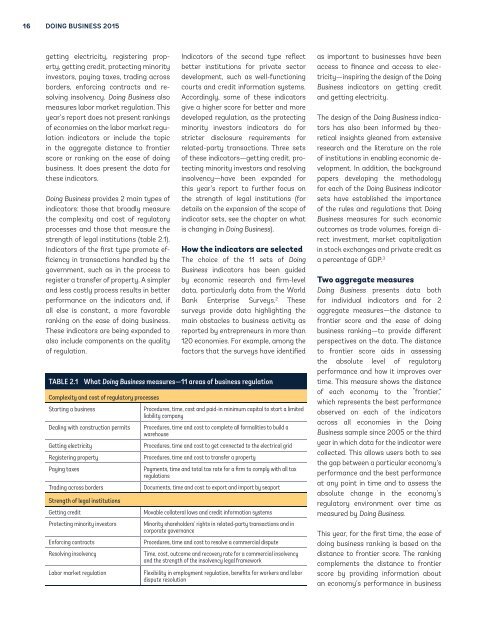bc8G2-7
bc8G2-7
bc8G2-7
Create successful ePaper yourself
Turn your PDF publications into a flip-book with our unique Google optimized e-Paper software.
16<br />
DOING BUSINESS 2015<br />
getting electricity, registering property,<br />
getting credit, protecting minority<br />
investors, paying taxes, trading across<br />
borders, enforcing contracts and resolving<br />
insolvency. Doing Business also<br />
measures labor market regulation. This<br />
year’s report does not present rankings<br />
of economies on the labor market regulation<br />
indicators or include the topic<br />
in the aggregate distance to frontier<br />
score or ranking on the ease of doing<br />
business. It does present the data for<br />
these indicators.<br />
Doing Business provides 2 main types of<br />
indicators: those that broadly measure<br />
the complexity and cost of regulatory<br />
processes and those that measure the<br />
strength of legal institutions (table 2.1).<br />
Indicators of the first type promote efficiency<br />
in transactions handled by the<br />
government, such as in the process to<br />
register a transfer of property. A simpler<br />
and less costly process results in better<br />
performance on the indicators and, if<br />
all else is constant, a more favorable<br />
ranking on the ease of doing business.<br />
These indicators are being expanded to<br />
also include components on the quality<br />
of regulation.<br />
TABLE 2.1<br />
Indicators of the second type reflect<br />
better institutions for private sector<br />
development, such as well-functioning<br />
courts and credit information systems.<br />
Accordingly, some of these indicators<br />
give a higher score for better and more<br />
developed regulation, as the protecting<br />
minority investors indicators do for<br />
stricter disclosure requirements for<br />
related-party transactions. Three sets<br />
of these indicators—getting credit, protecting<br />
minority investors and resolving<br />
insolvency—have been expanded for<br />
this year’s report to further focus on<br />
the strength of legal institutions (for<br />
details on the expansion of the scope of<br />
indicator sets, see the chapter on what<br />
is changing in Doing Business).<br />
How the indicators are selected<br />
The choice of the 11 sets of Doing<br />
Business indicators has been guided<br />
by economic research and firm-level<br />
data, particularly data from the World<br />
Bank Enterprise Surveys. 2 These<br />
surveys provide data highlighting the<br />
main obstacles to business activity as<br />
reported by entrepreneurs in more than<br />
120 economies. For example, among the<br />
factors that the surveys have identified<br />
What Doing Business measures—11 areas of business regulation<br />
Complexity and cost of regulatory processes<br />
Starting a business<br />
Dealing with construction permits<br />
Getting electricity<br />
Registering property<br />
Paying taxes<br />
Trading across borders<br />
Strength of legal institutions<br />
Getting credit<br />
Protecting minority investors<br />
Enforcing contracts<br />
Resolving insolvency<br />
Labor market regulation<br />
Procedures, time, cost and paid-in minimum capital to start a limited<br />
liability company<br />
Procedures, time and cost to complete all formalities to build a<br />
warehouse<br />
Procedures, time and cost to get connected to the electrical grid<br />
Procedures, time and cost to transfer a property<br />
Payments, time and total tax rate for a firm to comply with all tax<br />
regulations<br />
Documents, time and cost to export and import by seaport<br />
Movable collateral laws and credit information systems<br />
Minority shareholders’ rights in related-party transactions and in<br />
corporate governance<br />
Procedures, time and cost to resolve a commercial dispute<br />
Time, cost, outcome and recovery rate for a commercial insolvency<br />
and the strength of the insolvency legal framework<br />
Flexibility in employment regulation, benefits for workers and labor<br />
dispute resolution<br />
as important to businesses have been<br />
access to finance and access to electricity—inspiring<br />
the design of the Doing<br />
Business indicators on getting credit<br />
and getting electricity.<br />
The design of the Doing Business indicators<br />
has also been informed by theoretical<br />
insights gleaned from extensive<br />
research and the literature on the role<br />
of institutions in enabling economic development.<br />
In addition, the background<br />
papers developing the methodology<br />
for each of the Doing Business indicator<br />
sets have established the importance<br />
of the rules and regulations that Doing<br />
Business measures for such economic<br />
outcomes as trade volumes, foreign direct<br />
investment, market capitalization<br />
in stock exchanges and private credit as<br />
a percentage of GDP. 3<br />
Two aggregate measures<br />
Doing Business presents data both<br />
for individual indicators and for 2<br />
aggregate measures—the distance to<br />
frontier score and the ease of doing<br />
business ranking—to provide different<br />
perspectives on the data. The distance<br />
to frontier score aids in assessing<br />
the absolute level of regulatory<br />
performance and how it improves over<br />
time. This measure shows the distance<br />
of each economy to the “frontier,”<br />
which represents the best performance<br />
observed on each of the indicators<br />
across all economies in the Doing<br />
Business sample since 2005 or the third<br />
year in which data for the indicator were<br />
collected. This allows users both to see<br />
the gap between a particular economy’s<br />
performance and the best performance<br />
at any point in time and to assess the<br />
absolute change in the economy’s<br />
regulatory environment over time as<br />
measured by Doing Business.<br />
This year, for the first time, the ease of<br />
doing business ranking is based on the<br />
distance to frontier score. The ranking<br />
complements the distance to frontier<br />
score by providing information about<br />
an economy’s performance in business


